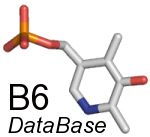|
|
| |
4.2.1.122 |
| Description |
Tryptophan synthase (indole-salvaging) |
| Catalyzed reaction |
O-phospho-L-serine + indole = L-tryptophan + phosphate
|
| Cofactor |
Pyridoxal-phosphate. |
| Comments |
Most mesophilic bacteria have a multimeric tryptophan synthase complex (EC 4.2.1.20) that forms L-tryptophan from L-serine and 1-C- (indol-3-yl)glycerol 3-phosphate via an indole intermediate.
This intermediate, which is formed by the alpha subunits, is transferred in an internal tunnel to the beta units, which convert it to tryptophan.
In thermophilic organisms the high temperature enhances diffusion and causes the loss of indole.
This enzyme, which does not combine with the alpha unit to form a complex, salvages the lost indole back to L-tryptophan.
It has a much lower Km for indole than the beta subunit of EC 4.2.1.20. |
| |
These enzymes also catalyze, with lower efficiency, the classic tryptophan synthase (beta subunit) reaction:
L-serine + indole <=> L-tryptophan + H(2)O |
| PDB |
4QYS; |
| Organisms |
-Archea |
| | |
|---|
Family |
|
| | |
|---|
| Links |
Enzyme (activities) 4.2.1.122
BRENDA (activities) 4.2.1.122
KEGG (pathways) 4.2.1.122
PLPMDB (PLP mutants) 4.2.1.122
|
| | |
|---|
| References |
Busch F, Rajendran C, Mayans O, Löffler P, Merkl R, Sterner R. (2014) TrpB2 enzymes are O-phospho-l-serine dependent tryptophan synthases Biochemistry 53 6078-83. Hiyama T, Sato T, Imanaka T, Atomi H. (2014) The tryptophan synthase β-subunit paralogs TrpB1 and TrpB2 in Thermococcus kodakarensis are both involved in tryptophan biosynthesis and indole salvage FEBS J 281 3113-25. Yin R, Frey M, Gierl A, Glawischnig E
(2010) Plants contain two distinct classes of functional tryptophan synthase beta proteins Phytochemistry 14-15 1667-72. Hettwer, S.; Sterner, R. (2002) A novel tryptophan synthase beta-subunit from the hyperthermophile Thermotoga maritima. Quaternary structure, steady-state kinetics, and putative physiological role J Biol Chem 277 8194-201. |
| | |
|---|
| last changed |
2018/01/29 14:31 |
|











